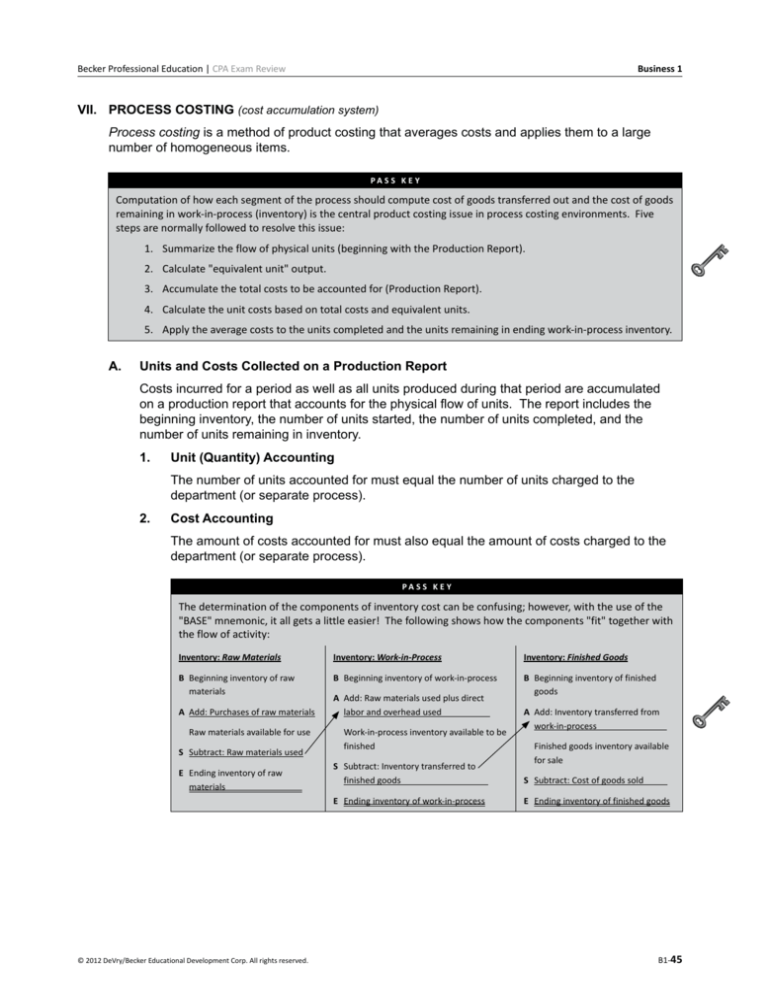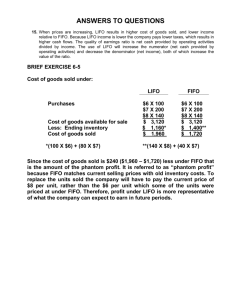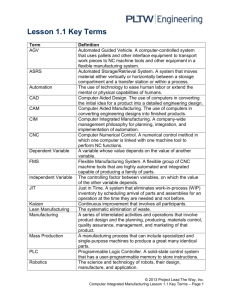
Business 1
Becker Professional Education | CPA Exam Review
VII. PROCESS COSTING (cost accumulation system)
Process costing is a method of product costing that averages costs and applies them to a large
number of homogeneous items.
PA S S K E Y
Computation of how each segment of the process should compute cost of goods transferred out and the cost of goods
remaining in work-in-process (inventory) is the central product costing issue in process costing environments. Five
steps are normally followed to resolve this issue:
1. Summarize the flow of physical units (beginning with the Production Report).
2. Calculate "equivalent unit" output.
3. Accumulate the total costs to be accounted for (Production Report).
4. Calculate the unit costs based on total costs and equivalent units.
5. Apply the average costs to the units completed and the units remaining in ending work-in-process inventory.
A.
Units and Costs Collected on a Production Report
Costs incurred for a period as well as all units produced during that period are accumulated
on a production report that accounts for the physical flow of units. The report includes the
beginning inventory, the number of units started, the number of units completed, and the
number of units remaining in inventory.
1.
Unit (Quantity) Accounting
The number of units accounted for must equal the number of units charged to the
department (or separate process).
2.
Cost Accounting
The amount of costs accounted for must also equal the amount of costs charged to the
department (or separate process).
PA S S K E Y
The determination of the components of inventory cost can be confusing; however, with the use of the
"BASE" mnemonic, it all gets a little easier! The following shows how the components "fit" together with
the flow of activity:
Inventory: Raw Materials
Inventory: Work-in-Process
Inventory: Finished Goods
B Beginning inventory of raw
materials
B Beginning inventory of work-in-process
B Beginning inventory of finished
goods
A Add: Purchases of raw materials
Raw materials available for use
S Subtract: Raw materials used
E Ending inventory of raw
materials
A Add: Raw materials used plus direct
labor and overhead used
Work-in-process inventory available to be
finished
S Subtract: Inventory transferred to
finished goods
E Ending inventory of work-in-process
© 2012 DeVry/Becker Educational Development Corp. All rights reserved.
A Add: Inventory transferred from
work-in-process
Finished goods inventory available
for sale
S Subtract: Cost of goods sold
E Ending inventory of finished goods
B1-45
Business 1
Becker Professional Education| CPA Exam Review
E X A M P L E — P R O D U C T I O N R E P O R T I L L U S T R AT E D
Quantities
Charged to dept:
In process, beginning 5,000
Transferred in
20,000
Total units charged to department
25,000
Units accounted for:
Transferred out 15,000
In process, end
10,000
Total units accounted for
25,000
Costs
Charged to dept:
$ 12,000
In process, beginning
During the period
85,000
Total units charged to department
$97,000
Costs accounted for:
Transferred out
$ 60,000
In process, end
37,000
Total costs accounted for
B.
$97,000
Equivalent Units
Costs must be attached to the completed units as well as to the units that are partially
complete at the end of each period. This calculation is made by taking into account the
partially completed units and by making use of equivalent units.
PA S S K E Y
Accounting for the physical flow of units is an important step in process costing. Remember, however,
that the pure physical flow of units will be different from the equivalent units of production.
1.
Equivalent Unit Defined
An equivalent unit of direct material, direct labor, or conversion costs (direct labor plus
factory overhead) is equal to the amount of direct material, direct labor, or conversion
costs necessary to complete one unit of production.
EXAMPLE
10,000 actual units of DM, DL, or OH in process that are 75% complete would represent 7,500 equivalent
units of (DM, DL, or OH) production.
B1-46
© 2012 DeVry/Becker Educational Development Corp. All rights reserved.
Becker Professional Education | CPA Exam Review
2.
Business 1
Process Costing Assumptions
a.
Transfers In are 100% Complete
Transfers in from departments are always considered 100% complete. The transfer
in costs of direct material from a previous department are treated as direct materials
(DM), even though they are called "transfer in" costs or "previous department"
costs.
b.
Timing of Addition of Direct Material
(1) Addition at the Beginning or During a Process
Direct material added at the beginning of or during a second or later process
may either be 100% complete or "partially complete," depending on how much
work has been done on that component of the process.
(2) Addition at the End of a Process
Any material added at the (very) end of a process will not be in work-inprocess inventory at the month end.
C.
Costing Issues
1.
Calculations of Average Unit Costs
The calculation of average unit costs and the application of those costs to various
segments of the process is complicated by a number of issues.
a.
Averaging of Costs from Prior Month's WIP
Frequently, costs from the previous month's work-in-process inventory are different
from costs of the current month. These costs must be averaged.
b.
Cost Flow Assumptions
Cost averaging computations depend upon FIFO and/or weighted (or moving)
average cost flow assumptions. These computations require a well-labeled account
analysis format for each unit of direct material, direct labor, or overhead.
D.
Specific Cost Flow Assumptions
1.
Calculation Using First-In First-Out (FIFO)
Under FIFO accounting, the ending inventory is priced at the cost of manufacturing during
the period, assuming that the beginning inventory was completed during the period.
a.
Equivalent Unit Components
The equivalent units are composed of three separate elements:
(1) Completion of units on hand at the beginning of the period
(2) Units started and completed during the period (Units completed - Beginning
WIP)
(3) Units partially complete at the end of the period
b.
Cost Components
Current costs incurred during the period are allocated to the equivalent units
produced during the period.
© 2012 DeVry/Becker Educational Development Corp. All rights reserved.
B1-47
Business 1
Becker Professional Education| CPA Exam Review
2.
Calculation Using Weighted-Average
The weighted-average cost method averages the cost of production during the period
with the costs in the beginning work-in-process inventory.
a.
Equivalent Unit Components
The equivalent units are composed of two elements:
(1) Units completed during the month (regardless of when the work was done)
(2) Units partially complete at the end of the period
b.
Cost Components
Total costs include both the costs of beginning inventory and current costs are
allocated to equivalent units to arrive at a weighted-average unit cost.
EXAMPLE—EQUIVALENT UNITS OF PRODUC TION
Assume the following information:
Work-in-process, beginning
100 units, 25% complete
Units completed and transferred out
600 units
Work-in-process, ending
200 units, 40% complete
Weighted-Average Equivalent Units of Production
Units completed and transferred out (always 100%)
600
Work-in-process, ending
200 units × 40%
80
Equivalent units of production
680
FIFO Equivalent Units of Production
Work-in-process, beginning
100 units × 75% (to complete)
75
Units started and completed this period
Units completed and transferred out
Units in beginning inventory
600
(100)500
Work-in-process, ending
200 units × 40%
80
Equivalent units of production 655
B1-48
© 2012 DeVry/Becker Educational Development Corp. All rights reserved.
Business 1
Becker Professional Education | CPA Exam Review
3.
Comparison of FIFO and Weighted-Average
a.
Unit Components
Equivalent unit calculation under FIFO consists of three elements representing
current period production, whereas the calculation under the weighted-average
method consists of only two elements that embrace units completed and are
available in beginning inventory.
b.
Cost Components
FIFO represents only costs incurred in the current period. The weighted-average
approach includes both current period units plus prior period units.
PA S S K E Y
Equivalent units of production may be computed using either First In First Out (FIFO) or weightedaverage assumptions. The FIFO approach specifically accounts for work to be completed, while
the weighted-average approach blends the units as follows:
1.
Weighted-average (2 steps)
a. Units completed
XXX
b. Ending WIP × % completed
XXX
+
Equivalent units
XXX
2.
FIFO (3 steps)
a. Beginning WIP × % to be completed
XXX
b. Units completed—Beginning WIP
+
XXX
c. Ending WIP × % completed
+
XXX
Equivalent units
XXX
PA S S K E Y
Cost per equivalent unit is computed by dividing total costs by equivalent units. FIFO anticipates
using only current costs, while the weighted-average approach uses both beginning inventory and
current costs as follows:
1.Weighted-average
WeightedBeginning cost + Current cost
=
average
Equivalent units
2.FIFO
FIFO =
Current cost only
Equivalent units
© 2012 DeVry/Becker Educational Development Corp. All rights reserved.
B1-49
Business 1
Becker Professional Education| CPA Exam Review
EXAMPLe
Comprehensive Example of Process Costing under FIFO and Weighted-Average
The following problem illustrates process costing using both the FIFO and weighted-average approaches. Note that separate
unit costs for materials and conversion (direct labor and manufacturing overhead) must be determined.
Comprehensive Example
Process Costing Under FIFO and Weighted-Average
May 20X1
FACT PATTERN
Percent
Complete
Materials
1 Units in process, May 1
Materials
Conversion
100%
40%
4,000
2 Units started and completed in May
Materials
Conversion
100%
100%
10,000
3 Units in process, May 31
Materials
Conversion
100%
80%
2,000
Total
4,000
10,000
2,000
4 Costs associated with May 1 WIP
Materials
Conversion
$ 1,000
5 Costs associated with May production
Materials
Conversion
$24,000
6 Total Costs
Conversion
$ 3,000
$ 1,000
3,000
$49,000
24,000
49,000
$77,000
Requirements
Complete a Production Report for Units and Costs
Complete Equivalent Units using FIFO and Weighted-Average
Complete Unit Cost of Production using FIFO and Weighted-Average
B1-50
© 2012 DeVry/Becker Educational Development Corp. All rights reserved.
Business 1
Becker Professional Education | CPA Exam Review
E X A M P L e ( continued )
COMPUTE A PRODUCTION REPORT
First In First Out
Materials
Weighted-Average
Conversion
Materials
Conversion
Quantities
1 Units in process, May 1
Units transferred in
Total units charged to department
4,000
12,000
16,000
4,000
11,600
15,600
4,000
12,000
16,000
4,000
11,600
15,600
2 Units transferred out
3 Units in process, May 31
Total units accounted for
14,000
2,000
16,000
14,000
1,600
15,600
14,000
2,000
16,000
14,000
1,600
15,600
$ 1,000
24,000
$25,000
$ 3,000
49,000
$52,000
$ 1,000
24,000
$25,000
$ 3,000
49,000
$52,000
$21,000
4,000
$25,000
$46,400
5,600
$52,000
$21,875
3,125
$25,000
$46,667
5,333
$52,000
Costs
4 Costs in WIP, May 1
5 Costs during May
Total costs charged to department
Costs transferred out (plug)
Costs of WIP at May 31 (EU x Cost per EU)
Total costs accounted for
COMPUTE EQUIVALENT UNITS OF PRODUCTION
First In First Out
Materials
1 Units in process, May 1
2 Units started and completed in May
3 Units in process, May 31
COMPUTE EQUIVALENT COST PER UNIT
Equivalent cost per unit
E.
Conversion
2,400
10,000
1,600
4,000
10,000
2,000
4,000
10,000
1,600
12,000
14,000
16,000
15,600
16,000
15,600
(4,000)
12,000
(1,600)
14,000
–
49,000
$ 1,000
24,000
$ 3,000
49,000
$24,000
$49,000
$25,000
$52,000
$
$
$ 1.56
$ 3.33
Alternative FIFO Computation
Total Units accounted for
Equivalent Units from prior periods included
in beginning inventory
Equivalent units
Total Costs
Materials
10,000
2,000
Total Units
COMPUTE UNIT COST OF PRODUCTION
4 Costs in WIP, May 1
5 Costs during May
Weighted-Average
Conversion
$
–
24,000
2.00
$
3.50
Spoilage (or shrinkage)
Spoilage (or shrinkage) is generally taken care of automatically because the equivalent units
added for the month are generally less than the actual units added during the month due to
problems with the production process.
© 2012 DeVry/Becker Educational Development Corp. All rights reserved.
B1-51









